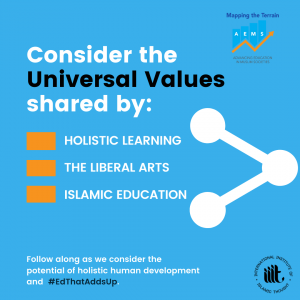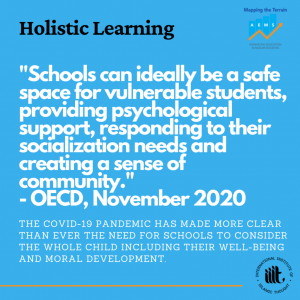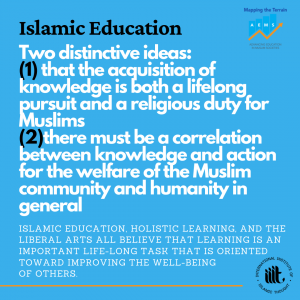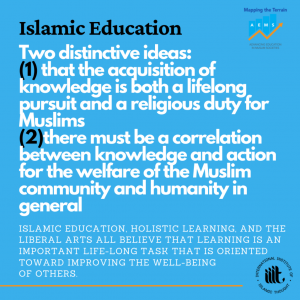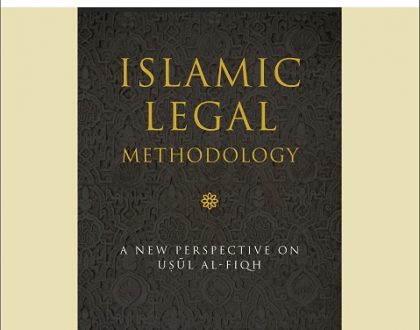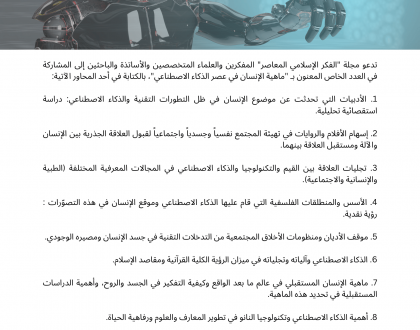AEMS BRIEF #6: BUILDING AND INVESTING IN A COLLABORATIVE COLLECTIVE
The third umbrella category explored by the Mapping the Terrain study is the Collaborative Collective. This is a unique construct selected specifically for this study, aiming to capture the collective nature of Muslim-majority societies while accounting for the collaborative aspects required for a collective to work. Just like the two previously discussed umbrella constructs, Open-Mindedness and Responsibility (for more on them, see our previous briefs), the Collaborative Collective is not only necessary for social transformation but also a key feature of an effective classroom community. This week we will explore the ways in which educators in both collectivist and individualistic societal contexts can promote collaborative collective learning environments that highlight the interdependence of humanity.
The construct of the Collaborative Collective includes values and skills intentionally selected but not necessarily limited to a collectivist orientation, sense of belonging, and forgiveness. This brief will go into greater detail on each of the skills included especially providing resources for educators on ways to integrate these into their curriculum and making the case for their significance in human development. The Mapping the Terrain research aims to provide baseline measures of these critical social and emotional skills and values in 15 Muslim-societies, and over the long-term we hope to be part of a movement that elevates these skills and values across educational systems to the levels of importance of academic skills and achievement.
Promoting a Collbaorative Collective
Deciding to bring the collectivist-individualist societal orientation into the classroom is an important initial task for educators when designing their classrooms. For example, the hyper-competitiveness driven by the global testing paradigm can promote a very individualistic approach to learning that sees academic achievement as a zero-sum game. Viewing K-12 education as primarily a proving ground for young people to demonstrate their superiority (or inferiority) relative to their peers is an easy trap to fall into, and there is a whole vocabulary of programs organized around this idea: tracking, magnet schools, selective-enrollment, etc. This is understandably most acute in individualistic societies like the United States, but educational systems in more collectivist societies such as China can suffer the consequences of individualism as well. Proponents of such an approach to teaching and learning will say that competition is a necessary driver of achievement and that competitive classrooms and schools prepare young people for the realities of a competitive adult world. Elements of this argument may be true, but research over the last several years into how children learn along with a renewed emphasis on equity suggest that collaborative classrooms are not only more enjoyable but also more productive.
No matter the baseline orientation of the student body, teachers can promote collaboration in their classrooms. Some strategies for doing this include games that require working together as a community, specific roles for group work that necessitate every team member’s contribution, and various brainstorming, discussion, and peer-feedback activities before and after individual work. For students that are used to very individualistic academic tasks, there may be some initial challenges in implementing these sorts of collaborative exercises. But if a collectivist classroom is implemented with fidelity, then students will see the benefits of working with and learning from one another.
Cultivating a Sense of Belonging
In an academic setting, sense of belonging is defined as students’ perception of being supported, accepted, respected, and included in the institution (Goodenow, 1993). Shifting students’ orientation towards their peers from one of competition to one of collaboration can itself go a long way towards giving students a sense of belonging in their classrooms. However, as with most things, explicitly and deliberately focusing on building a community of learners will extend this sense of belonging to the classroom and school. Educators have known the importance of a strong community for a long time, and there are plenty of community-building resources available for different age groups and teaching styles. These can range from simple daily practices such as greeting each student by name at the door, to more comprehensive collaboration with students in the design and upkeep of their learning environment. Exciting new work into Youth-led Participatory Action Research (YPAR) trains young people to conduct systematic research to improve their lives, their communities, and the institutions intended to serve them. This sort of work has been shown to not only improve the sense of belonging and experience of young people in their present contexts, but also leads to long-term engagement from them in their future communities. The increase in the feeling of belonging to the school and community will also improve and elevate the sense of a collaborative collective.
Modeling Forgiveness
In this study, forgiveness is defined as the ability and willingness to let go of hard feelings and the need to seek revenge on someone who has wronged the subject or committed a perceived injustice against the subject or others. Forgiveness is an essential part of a collaborative collective, because people are social animals and they rely on interacting with others. In order to be a positive member of a collective, you must be willing and able to forgive. Forgiveness is a deeply personal action, and the ways in which it is conceptualized are often deeply tied to one’s particular social, cultural, and religious contexts. Teachers can model forgiveness by purposefully modulating their own behavior and emotions and offering radical forgiveness to their students who misbehave or transgress – that is, forgiving fully and freely with no expectation for anything in return. When students see their teachers forgive their peers they not only come to like and respect their teachers more, but they also learn an important lesson of the power of forgiveness, not only for the person on the receiving end but also for the forgiver themselves. A forgiving school culture creates a more positive workplace and learning environment for every member of the school community.
***
Encouraging young people to see themselves as part of a collaborative collective is an important step in promoting positive and pro-social life-long behaviors. Educators concerned with the holistic well-being of their students over the short- and long-term would do well to implement some of the strategies discussed in this brief. A classroom where everyone is actively contributing to the collective good, feels a sense of belonging, and believes in the power of forgiveness is a classroom where young people can learn and thrive. When they bring these learnings and mindsets into the adult world, they are prepared to co-create collaborative collectives across all levels of society.
As this work continues, we hope that you will engage with us in thinking through the implications of this research. You can do that by responding to this email with any thoughts, by following us on Instagram (@iiit_insta) and Twitter (@iiitfriends), and by forwarding this message to anyone in your life who might find it interesting.
Thank you and all the best,
Alex Koenig,
Non-Resident Fellow in Human Development and Education Policy
The Advancing Education in Muslim Societies (AEMS) Team
The International Institute of Islamic Thought.

